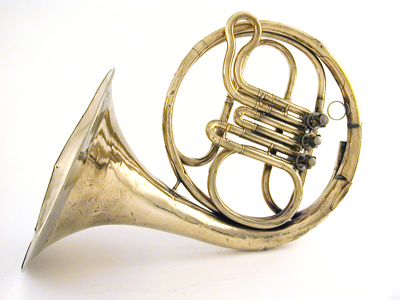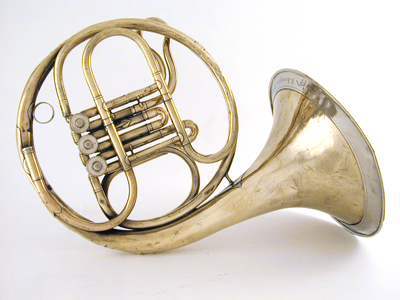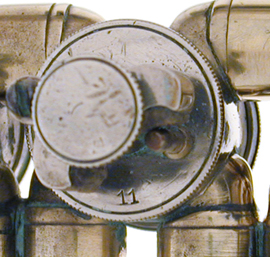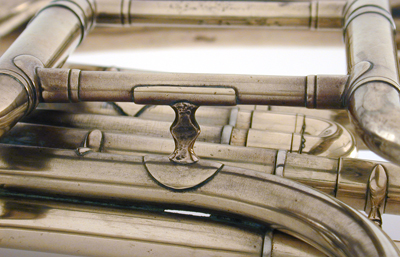Label (on garland):
|
E. Kruspe in Erfurt |
|
Model:
|
Single with Terminal Crook |
|
Serial Number:
|
none |
|
Date of Manufacture:
|
ca. 1870? |
|
Key(s):
|
Determined by terminal crook |
|
Valves:
|
3 rotary |
|
Bore:
|
1.19 cm. |
|
Bell Flare:
|
wide vee-gusset with garland |
|
Bell Throat:
|
6.4 cm. |
|
Bell Diameter:
|
28.4 cm. |
|
Base Metal:
|
yellow brass with nickel-silver trim |
|
Finish:
|
unlacquered |
.
(click on photos for larger view)
|

|

|
The firm of Ed. Kruspe was established in Erfurt, Germany in 1864 by Johann Eduard Kruspe
(1831-1919), elder son of Carl Kruspe (1808 - 1885). Carl
Kruspe had established his workshop originally in Mühlhausen in Thüringen (1829 - 1836)
then Erfurt (1836 - after 1930) for the manufacture of brass and woodwind instruments. Rather than
going into business with his father, Eduard established his own workshop as successor
to Carl Zielsdorf. In 1893 operation of the firm was turned over to Eduard's son, Fritz
Kruspe (ca. 1862 - 1909) and has continued to the present under the name "Ed. Kruspe".
Several features of this horn indicate an early date of manufacture. First, the main body of
the horn is of the pattern found on the very early
German Orchesterhorn.
In this layout dating back to the mid seventeenth century, the main tubing is simply cut
and bent into the center of the circle to form the legs of the tuning slide. It was soon
found that crossing the tuning slide legs at their base resulted in a stronger design.
This improvement was adopted by most makers outside of Germany, but the old pattern
was retained by many German and Austrian makers.
Second, the very unusual priapic shape of the first valve slide argues
for an early design and is not found anywhere else, including later Kruspes. And finally the name
engraved on the bell garland is "E. Kruspe in Erfurt.", which, while most certainly refering to
Eduard Kruspe, is not the manner in which the firm has been known for well over a
century. The common labeling on horns from this firm are either simply "Kruspe in Erfurt"
(like this and
this) or "Ed. Kruspe"/"Erfurt"
(like this).
|
The garland on the bell features an acorn motif
which is also found on
another horn in this collection. (See below for acorn symbolism and its place in
German history.)
|

|

|

|
Above left, the valve rotor section bears the number 11. This is not a serial number for
the horn, rather it is undoubtedly merely a work number used by the fabricator of the
valve machine to keep the various parts together. Note, that the valve levers and clockwork
springs have been removed by a previous owner. At right, an elegant brace secures
the main tuning slide to the valve section.
|
Acorn Symbolism
The acorn is considered by some to be an emblem of luck, prosperity, youthfulness and
power, and also represents spiritual growth. During the Norman Conquest, the English
carried dried acorns to protect themselves from the brutalities of the day.
It can also symbolize that great successes often develop from something very small, as in
the commonly quoted phrase "Mighty (or great) oaks from tiny acorns grow."
In Germany, the oak tree stood for traditional
values such as truth, longevity, and loyalty, and in the eighteenth and nineteenth
centuries it came to symbolize Germany itself. The playwright and poet, Friedrich Gottlieb Klopstock,
(1724 - 1803) hailed it as a national symbol in his play, Hermanns Schlacht:
"You are the thickest, shadiest oak...the highest, oldest, most sacred oak, O fatherland."
Oak leaves are a prominent symbol on most German military orders. For example, in 1813
Frederick William III, King of Prussia, added a spray of gilt oak leaves
to his kingdom's highest military honor, the Pour le Mérite
("Blue Max") as an additional distinction. At that time Erfurt where this horn was made was a city in the
Province of Saxony within the Kingdom of Prussia. Oak trees are common in the region and a
350-year-old oak tree still stands inside the Natural History Museum in Erfurt.
|




